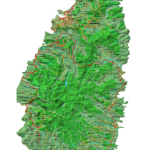General Country Information: St. Lucia
Population: 179700 (2018)
Economy:
GPD: 1,737.5 Million USD (2017)
(greatest economic sectors): Primary industry (Tourism, agriculture)
Secondary Industry (manufacturing)
Tertiary Industry (service)
Landuse (a map would be an asset),
Spatial development plan and/or Strategic Development for the country (provide link to document or website if possible)
Map, picture of the flag
Background - major rivers, water sources, reservoirs
Refer to Water Resources Management Agency
General information on water quantity and quality (maps would be an asset)
- Annual long-term rainfall
- Proposed threats to climate change
Refer to Water Resources Management Agency
Institutional and regulatory framework
The Water and Sewerage Company Inc. (WASCO)[1], wholly owned by the Government of St. Lucia, is responsible for the provision of water and wastewater services in St. Lucia. WASCO is responsible for water abstraction, treatment and distribution of potable water as well as the provision of sewerage services in available regions. In addition, there are a number of private providers of bottled water which is sourced from either private springs or utility piped water.
The guidelines used for both water quality and wastewater are based on the water quality guidelines established by the World Health Organisation (WHO).
[1] http://www.wascosaintlucia.com/
The National Utilities Regulatory Commission (NURC) is the independent body responsible for regulating the water supply and sewerage services and the electricity services in Saint Lucia. The regulatory body was established pursuant to the National Utilities Regulatory Commission Act No. 3 of 2016.
Water management
- Is there a hydrological monitoring network
- Identify major Water Management issues
- List Water Sector Development Needs
- New developments in Water Resources Management and areas for research
Refer to Water Resources Management Agency
Water is sourced primarily from surface water (rivers and springs). Water is abstracted from various intakes across Saint Lucia, goes through a treatment process and distributed to households and businesses. There are 8 intakes servicing the north of the island (from Anse la Raye to Gros Islet) and 22 intakes servicing the south of the island (from Dennery in the east to Vieux Fort in the south and to Canaries in the west).
The John Compton Dam (JCD) located on the Roseau River is the main storage reservoir which services most of the North of the island and has a design capacity of 3 million m3. The water from the is conveyed to the Theboalds Water Treatment Plant for treatment and then distributed across several communities in the northern of the island from Bexon to Cap Estate in the extreme north.
From the total water produced by WASCO, it is estimated that 57% is used for domestic purposes (including agriculture), 17% by the hotel sector, 13% by the commercial/industrial sector and the remaining 12% by the government (including schools and hospitals).
Almost 100% of Saint Lucia’s population has access to potable water supplied by WASCO. Although some areas have a daily supply of water, some sections of the population which have a less frequent supply of water rely on private water storage tanks and containers to maintain service during off schedule periods. Customer service programs are available to assist customers including fault reporting to WASCO’s Control Room. Social media is also used as part of customer support to keep customers informed on issues such as disruptions in service, ongoing projects and water and sewer emergencies.
The adverse effects of climate change and other hazards pose a threat to WASCO’s infrastructure. These hazards and climatic events include hurricanes, flooding, landslides, drought and high winds. Some of the consequences of these threats on water availability and WASCO’s ability to provide potable water are:
- High levels of sedimentation;
- Reduced capacity of reservoir;
- Clogging of intakes;
- Low water level within rivers and springs;
- Low volumes of available treated water due to longer drier spells;
- High level of turbidity from raw water sources;
- Damage to pumping stations and transmission lines; and
- Loss of power to pumping stations.
Wastewater coverage in St. Lucia is limited to an estimated 7% of the population through the public centralized system. There are four (4) sewerage systems in St. Lucia which are operated and maintained by WASCO:
- Castries which serves approximately 15% of greater Castries and covers the business area. The network is limited to a wastewater collection system which discharges raw sewage into the marine environment via a near shore outfall;
- A sewerage system which includes collection, treatment and disposal located at Rodney Bay, to the north of the Island and primarily serves residential areas and hotels. The treatment capacity of this plant is 2.4MGD and treatment is through stabilization ponds; and
- The Emerald Development and Black Bay wastewater treatment plants. These facilities are small package treatment plants designed to support housing developments where sewage is collected, treated and discharged into the natural environment within acceptable environmental limits as outlined by the World Health Organisation (WHO).
Institutional and regulatory framework
- The Institution(s) responsible for provision of wastewater services (include link to websites)
- Legislation, policies and plans to guide wastewater management and development (include link to websites) e.g.
- Wastewater Master Plans
- Relevant policies
- design standards for Wastewater options
- Wastewater emission standards
- Issues with wastewater management. Please include:
- Issues in enforcement of Standards and policies
- Development needs
- New development opportunities
- Opportunities for Wastewater Reuse
- Research interests
Background on Solid Waste management
Institutional and regulatory framework
- The Institution(s) responsible for provision of solid waste management services (include link to websites)
- Legislation, policies and plans to guide solid waste management and development (include link to websites) e.g.
- Solid Waste management Plan
- Relevant policies
- Management approaches
- Issues with Solid Waste management. Please include:
- Issues in enforcement of Standards and policies
- Development needs
- New development opportunities / current projects ( identify links project sites etc)
- Opportunities in Solid Waste management
- Research interests


